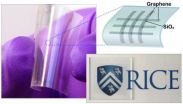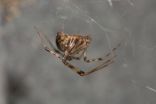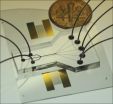(Press-News.org) (Edmonton) The University of Alberta's impact on the Alberta economy is estimated to be $12.3 billion, which is five per cent of the province's gross domestic product—or the equivalent of having 135 Edmonton Oilers NHL teams in Alberta, according to a new study.
"When a university educates a population, it's the whole region that benefits," said study co-author Anthony Briggs, an assistant professor in the Alberta School of Business at the U of A. "We're not looking at the cost of the education and research, which is just one slice, but estimating the value of the investment. Education and research impacts are substantial and spread across sectors—all areas of the economy share the benefit."
Modelled on similar studies first conducted by the University of British Columbia in 2009, the U of A report focused on the direct impact of institutional and visitor spending combined with induced economic impact from university education and research.
The study showed that U of A alumni earn more because of their university education. It also showed that the U of A is a stronger economic driver than UBC, Simon Fraser University and the University of Ottawa, the comparator universities used in the study.
"This research gives us a better understanding of the University of Alberta's importance to the Alberta economy, and indeed to the prosperity of Albertans, Canadians and the world," said U of A President Indira Samarasekera. "We enjoy that prosperity thanks to the inspiring work of our faculty, hard-working staff and talented alumni who prepare and create new opportunities for today's students and tomorrow's leaders."
Education premium
The U of A's economic impact exceeded UBC's own findings of $10.4 billion, as well as those of the University of Ottawa ($3.9 billion) and Simon Fraser University ($3.7 billion), which had previously done similar studies. A key driver of that success is from the "education premium"—higher-value economic activities that are driven by alumni educated at the U of A.
University of Alberta alumni resulted in a $4.1-billion education premium—1.5 times greater than UBC's ($2.7 billion), and outpacing Simon Fraser's ($1.7 billion) and the University of Ottawa's ($1.6 billion).
"The results are very robust," Briggs said, "and we know the difference is because we have a large alumni base in Alberta, where education really matters for earnings."
Research impact
The study also showed that research at the U of A has a larger impact on the provincial economy than the comparators, fuelled by research and development and the overall strength of the Alberta economy. U of A research over the last 30 years was estimated to have an indirect annual impact of $5.7 billion, slightly higher than that of UBC ($5 billion) and substantially higher than that of Simon Fraser ($852 million).
"When you look at research and development growth, the University of Alberta is a large player and has a higher institutional share," Briggs said.
The U of A study follows methodology developed at UBC, but represents the first time comparator universities have been shown side by side, he added.
"Universities have multiple avenues that contribute to societies, and this economic study is the first to measure impact relative to other Canadian institutions," he said. "In a way, this is starting to say, let's put us on the same page and measure the same thing—that should be a good thing for all institutions so that we all have common metrics."
###
The Economic Impact of the University of Alberta: A Comparative Approach represents the first in a series of studies by Briggs and co-author Jennifer Jennings to gauge the university's impact on the broader society. Samarasekera said the results exemplify the U of A's promise to "uplift the whole people," a promise fulfilled by the extraordinary people who push the boundaries of research, innovation and entrepreneurship for the benefit of Alberta and the global economy.
University of Alberta has $12.3-billion impact on Alberta economy
UAlberta is a vital part of Alberta's economic landscape, with an estimated impact of $12.3 billion or 5% of the province's gross domestic product.
2012-10-03
ELSE PRESS RELEASES FROM THIS DATE:
Visionary transparent memory a step closer to reality
2012-10-03
HOUSTON – (Oct. 2, 2012) – Researchers at Rice University are designing transparent, two-terminal, three-dimensional computer memories on flexible sheets that show promise for electronics and sophisticated heads-up displays.
The technique based on the switching properties of silicon oxide, a breakthrough discovery by Rice in 2008, was reported today in the online journal Nature Communications.
The Rice team led by chemist James Tour and physicist Douglas Natelson is making highly transparent, nonvolatile resistive memory devices based on the revelation that silicon ...
Starting antiretroviral therapy improves HIV-infected Africans' nutrition
2012-10-03
Starting HIV-infected patients on antiretroviral therapy reduces food insecurity and improves physical health, thereby contributing to the disruption of a lethal syndemic, UCSF and Massachusetts General Hospital researchers have found in a study focused on sub-Saharan Africa.
The study was published this week in the Journal of Acquired Immune Deficiency Syndromes.
With more than 20 million people infected with HIV/AIDS and almost 240 million people lacking access to enough food, sub-Saharan Africa is experiencing co-epidemics of food insecurity and HIV/AIDS that intensify ...
For elephants, deciding to leave watering hole demands conversation, Stanford study shows
2012-10-03
STANFORD, Calif. — In the wilds of Africa, when it's time for a family of elephants gathered at a watering hole to leave, the matriarch of the group gives the "let's-go rumble" — as it's referred to in scientific literature — kicking off a coordinated and well-timed conversation, of sorts, between the leaders of the clan.
First, the head honcho moves away from the group, turns her back and gives a long, slightly modulated and — to human ears — soft rumble while steadily flapping her ears. This spurs a series of back and forth vocalizations, or rumbles, within the group ...
University of Minnesota engineers invent new device that could increase Internet download speeds
2012-10-03
MINNEAPOLIS / ST. PAUL (10/02/2012) —A team of scientists and engineers at the University of Minnesota has invented a unique microscale optical device that could greatly increase the speed of downloading information online and reduce the cost of Internet transmission.
The device uses the force generated by light to flop a mechanical switch of light on and off at a very high speed. This development could lead to advances in computation and signal processing using light instead of electrical current with higher performance and lower power consumption.
The research results ...
1 glue, 2 functions
2012-10-03
Akron, Ohio, Oct. 2, 2012 — While the common house spider may be creepy, it also has been inspiring researchers to find new and better ways to develop adhesives for human applications such as wound healing and industrial-strength tape. Think about an adhesive suture strong enough to heal a fractured shoulder and that same adhesive designed with a light tackiness ideal for "ouch-free" bandages.
University of Akron polymer scientists and biologists have discovered that this house spider — in order to more efficiently capture different types of prey — performs an uncommon ...
Too little nitrogen may restrain plants' carbon storage capability, U of M paper shows
2012-10-03
MINNEAPOLIS / ST. PAUL (10/02/2012) —Plants' ability to absorb increased levels of carbon dioxide in the air may have been overestimated, a new University of Minnesota study shows.
The study, published this week in the journal Nature Climate Change, shows that even though plants absorb large amounts of carbon dioxide and actually can benefit from higher levels of it, they may not get enough of the nutrients they need from typical soils to absorb as much CO2 as scientists had previously estimated. Carbon dioxide absorption is an important factor in mitigating fossil-fuel ...
Acoustic cell-sorting chip may lead to cell phone-sized medical labs
2012-10-03
UNIVERSITY PARK, Pa. -- A technique that uses acoustic waves to sort cells on a chip may create miniature medical analytic devices that could make Star Trek's tricorder seem a bit bulky in comparison, according to a team of researchers.
The device uses two beams of acoustic -- or sound -- waves to act as acoustic tweezers and sort a continuous flow of cells on a dime-sized chip, said Tony Jun Huang, associate professor of engineering science and mechanics, Penn State. By changing the frequency of the acoustic waves, researchers can easily alter the paths of the cells.
Huang ...
Payoff lacking for casino comps
2012-10-03
A study of widely used complimentary offers at Atlantic City casinos finds that common giveaways such as free rooms and dining credits are less profitable – and lead to unhealthy competition among casinos – than alternative comps such as free travel and parking.
The research, co-authored by Seul Ki Lee, an assistant professor at Temple University's School of Tourism and Hospitality Management, analyzed monthly promotional allowance and expenditure data from 11 casinos in the Atlantic City market from 2008 to 2010. Atlantic City is the second largest gaming market in ...
Study reveals differences in overall health of Latino-American subgroups
2012-10-03
TALLAHASSEE, Fla. - Despite a shared Latino heritage, there are significant differences in the overall health and the use of health-care services among Cuban-Americans, Mexican-Americans and Puerto Rican-Americans — even between men and women in the same subgroup — according to two recently published studies by Florida State University researchers.
The authors, led by College of Social Work Professor and Associate Dean Amy L. Ai, evaluated the physical and behavioral health, as well as the health care service usage, of all three major Latino subgroups in the United States. ...
Cedars-Sinai study sheds light on bone marrow stem cell therapy for pancreatic recovery
2012-10-03
LOS ANGELES (Oct. 2, 2012) – Researchers at Cedars-Sinai's Maxine Dunitz Neurosurgical Institute have found that a blood vessel-building gene boosts the ability of human bone marrow stem cells to sustain pancreatic recovery in a laboratory mouse model of insulin-dependent diabetes.
The findings, published in a PLOS ONE article of the Public Library of Science, offer new insights on mechanisms involved in regeneration of insulin-producing cells and provide new evidence that a diabetic's own bone marrow one day may be a source of treatment.
Scientists began studying ...
LAST 30 PRESS RELEASES:
Making lighter work of calculating fluid and heat flow
Normalizing blood sugar can halve heart attack risk
Lowering blood sugar cuts heart attack risk in people with prediabetes
Study links genetic variants to risk of blinding eye disease in premature infants
Non-opioid ‘pain sponge’ therapy halts cartilage degeneration and relieves chronic pain
AI can pick up cultural values by mimicking how kids learn
China’s ecological redlines offer fast track to 30 x 30 global conservation goal
Invisible indoor threats: emerging household contaminants and their growing risks to human health
Adding antibody treatment to chemo boosts outcomes for children with rare cancer
Germline pathogenic variants among women without a history of breast cancer
Tanning beds triple melanoma risk, potentially causing broad DNA damage
Unique bond identified as key to viral infection speed
Indoor tanning makes youthful skin much older on a genetic level
Mouse model sheds new light on the causes and potential solutions to human GI problems linked to muscular dystrophy
The Journal of Nuclear Medicine ahead-of-print tip sheet: December 12, 2025
Smarter tools for peering into the microscopic world
Applications open for funding to conduct research in the Kinsey Institute archives
Global measure underestimates the severity of food insecurity
Child survivors of critical illness are missing out on timely follow up care
Risk-based vs annual breast cancer screening / the WISDOM randomized clinical trial
University of Toronto launches Electric Vehicle Innovation Ontario to accelerate advanced EV technologies and build Canada’s innovation advantage
Early relapse predicts poor outcomes in aggressive blood cancer
American College of Lifestyle Medicine applauds two CMS models aligned with lifestyle medicine practice and reimbursement
Clinical trial finds cannabis use not a barrier to quitting nicotine vaping
Supplemental nutrition assistance program policies and food insecurity
Switching immune cells to “night mode” could limit damage after a heart attack, study suggests
URI-based Global RIghts Project report spotlights continued troubling trends in worldwide inhumane treatment
Neutrophils are less aggressive at night, explaining why nighttime heart attacks cause less damage than daytime events
Menopausal hormone therapy may not pose breast cancer risk for women with BRCA mutations
Mobile health tool may improve quality of life for adolescent and young adult breast cancer survivors
[Press-News.org] University of Alberta has $12.3-billion impact on Alberta economyUAlberta is a vital part of Alberta's economic landscape, with an estimated impact of $12.3 billion or 5% of the province's gross domestic product.



